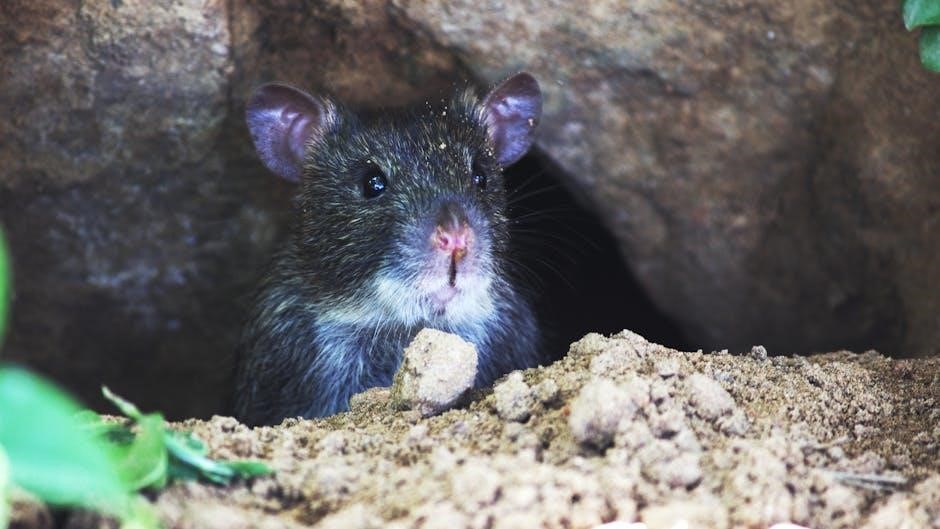Mrs. Frisby and the Rats of NIMH is a captivating children’s novel by Robert C. O’Brien‚ blending adventure‚ science fiction‚ and heartwarming themes. Published in 1971‚ it explores family‚ courage‚ and community through the story of a brave mouse mother and intelligent rats‚ offering timeless lessons and enchanting readers of all ages.
1.1 Overview of the Novel
Mrs. Frisby and the Rats of NIMH is a children’s novel by Robert C. O’Brien‚ published in 1971. It combines elements of adventure‚ science fiction‚ and heartwarming themes‚ following the journey of a courageous mouse mother and a group of intelligent rats. The story explores themes of family‚ sacrifice‚ and the ethical implications of scientific experimentation‚ captivating readers with its unique blend of action and emotional depth.
1.2 Author Background: Robert C. O’Brien
Robert C. O’Brien was an American author and journalist‚ best known for Mrs. Frisby and the Rats of NIMH. His work often blended adventure with philosophical themes‚ reflecting his deep interest in science and ethics. O’Brien’s visit to the National Institute of Mental Health inspired the novel‚ which he wrote for his children‚ showcasing his ability to craft engaging stories for young readers.

Plot Summary of “Mrs. Frisby and the Rats of NIMH”
The story follows a brave mouse mother’s quest to save her family‚ aided by a group of intelligent rats with a mysterious past‚ exploring themes of family‚ survival‚ and courage.

2.1 The Struggles of Mrs. Frisby
Mrs. Frisby‚ a devoted field mouse‚ faces immense challenges as she battles to protect her family. Her son Timothy’s severe illness and the threat of the farmer’s plow drive her to seek help from the intelligent rats of NIMH. Her journey highlights maternal love‚ determination‚ and perseverance in the face of adversity‚ showcasing her as a resilient and courageous character.
2.2 The Rats of NIMH: Their Origin and Intelligence
The rats of NIMH originated from a laboratory where scientists conducted experiments to enhance their intelligence. These rats developed extraordinary cognitive abilities‚ allowing them to speak‚ read‚ and solve complex problems. Their escape from the lab led to a secretive‚ organized community‚ showcasing their ingenuity and cooperation‚ making them unique among ordinary rats.
2.3 The Quest for a New Home
Mrs. Frisby and the rats embark on a perilous journey to find a safe haven. The rats seek a place to establish their colony‚ free from human threats‚ while Mrs. Frisby aims to protect her family from danger. Their shared quest highlights themes of cooperation‚ resilience‚ and the pursuit of a secure future for their loved ones.
Main Characters in the Novel
The story revolves around Mrs. Frisby‚ a brave and determined mouse mother‚ and the intelligent rats‚ including Nicodemus and Justin‚ who play pivotal roles in her journey.
3.1 Mrs. Frisby: The Courageous Mother
Mrs. Frisby‚ a determined and brave field mouse‚ embodies maternal love and resilience. She risks her life to save her family‚ particularly her ill son Timothy‚ showcasing unwavering courage and resourcefulness. Her journey highlights the power of perseverance and the unbreakable bond of a mother’s love‚ making her a deeply inspiring and relatable character in the novel.
3.2 The Rats: Nicodemus and Justin
Nicodemus‚ the wise and visionary leader of the rats‚ plays a pivotal role in assisting Mrs. Frisby. His intelligence and foresight guide the rats toward freedom. Justin‚ a brave and loyal rat‚ aids Mrs. Frisby in her quest‚ showcasing his courage and kindness. Together‚ they exemplify the rats’ extraordinary abilities and their commitment to helping others‚ making them central to the story’s success.
3.3 Other Key Characters: Timothy and Cynthia
Timothy‚ Mrs. Frisby’s sickly son‚ is a kind and thoughtful character whose illness drives much of the plot. His sister Cynthia is supportive and caring‚ showcasing the strength of family bonds. Both characters add depth to the story‚ highlighting themes of love and resilience as they navigate challenges alongside their mother and the rats of NIMH.
Themes Explored in the Novel
Mrs. Frisby and the Rats of NIMH delves into themes of family bonds‚ courage‚ and the ethical dilemmas surrounding intelligence‚ offering a rich exploration of societal structures and moral choices that resonate deeply with readers.
4.1 Family and Sacrifice
Mrs. Frisby and the Rats of NIMH profoundly explores the themes of family and sacrifice. Mrs. Frisby‚ a devoted mother‚ risks her life to save her son Timothy‚ showcasing the depth of maternal love. Her journey highlights the importance of family bonds and the sacrifices made to protect loved ones‚ emphasizing loyalty and selflessness as core values. The rats’ assistance further underscores the power of community in overcoming adversity‚ blending individual sacrifice with collective support to achieve a common goal. Through these elements‚ the novel delivers a poignant message about the enduring strength of family ties and the lengths to which love can drive individuals to act selflessly‚ even in the face of overwhelming challenges.
4.2 Courage and Perseverance
Mrs; Frisby and the Rats of NIMH highlights the power of courage and perseverance through its characters’ struggles. Mrs. Frisby‚ a timid mouse‚ shows extraordinary bravery to save her family‚ while the rats‚ led by Nicodemus‚ demonstrate resilience against adversity. Their determination inspires hope and resilience‚ proving that even the weakest can overcome daunting challenges through unwavering resolve and courage.
4.3 Intelligence and Ethics
Intelligence and Ethics are central themes‚ as the rats’ enhanced intelligence‚ resulting from lab experiments‚ raises moral questions. Their escape and survival challenge the ethics of scientific experimentation‚ highlighting the consequences of tampering with nature. The novel prompts reflection on the responsible use of intelligence and the ethical boundaries of human intervention in the natural world.
4.4 Society and Class
The novel explores societal hierarchies through the mice and rats’ interactions. Mice are portrayed as more civilized‚ while rats‚ often viewed as pests‚ struggle at the bottom of the food chain. This reflects broader themes of class and social stratification‚ with the rats’ dissatisfaction mirroring human societal discontent‚ despite their luxurious but confinement-driven existence.

The Rats of NIMH: Their Background and Significance
The rats of NIMH‚ once ordinary‚ gained extraordinary intelligence through laboratory experiments. Their journey from captivity to freedom symbolizes resilience and the ethical implications of scientific intervention.
5.1 The Laboratory Experiments
The rats of NIMH were subjected to genetic experiments at the National Institute of Mental Health‚ where scientists aimed to enhance their intelligence. Through injections and tests‚ the rats developed extraordinary cognitive abilities‚ enabling them to escape captivity and forge a secretive‚ sophisticated community‚ far beyond ordinary rodent capabilities.
5.2 The Rats’ Escape and New Life
After escaping the NIMH laboratory‚ the rats established a hidden society‚ utilizing their newfound intelligence to create a self-sufficient colony. They built complex structures and systems‚ showcasing their advanced problem-solving skills and adaptability. Their new life reflected their determination to thrive independently‚ free from human interference and experimentation.
5.3 The Vision of Nicodemus
Nicodemus‚ the wise leader of the rats‚ envisioned a future where his colony could live freely‚ far from human exploitation. His unwavering determination and strategic thinking inspired the rats to strive for independence and build a thriving society. Nicodemus’s vision laid the foundation for their new life‚ emphasizing freedom‚ unity‚ and the pursuit of a better tomorrow.

Symbolism in the Novel
Mrs. Frisby and the Rats of NIMH richly employs symbolism‚ with the rats representing resilience and freedom‚ the stone in Mrs. Frisby’s house symbolizing hidden strength‚ and the maze embodying challenges and escape.
6.1 The Stone in Mrs. Frisby’s House
The stone in Mrs. Frisby’s house symbolizes resilience and hidden strength. It serves as a physical obstacle but also a metaphor for the challenges she faces. The stone’s presence ties into her journey of courage and resourcefulness‚ highlighting her determination to protect her family and home amidst adversity. It is a powerful symbol throughout the story.
6.2 The Maze and the Laboratory
The maze and laboratory symbolize confinement and experimentation‚ highlighting the rats’ struggles. The maze represents their physical and psychological challenges‚ while the lab signifies their transformation through scientific experiments. These settings underscore the rats’ enhanced intelligence and their desire for freedom‚ driving the plot’s tension and their ultimate escape from oppression.
6.3 The Theme of Freedom
Freedom is a central theme‚ symbolizing escape from oppression and the pursuit of a better life. The rats’ journey from captivity to independence and Mrs. Frisby’s quest to save her family highlight the universal desire for liberation. Freedom in the novel is not just physical but also emotional‚ representing hope and self-determination.

The Legacy of “Mrs. Frisby and the Rats of NIMH”
The novel’s enduring popularity is evident in its availability as a PDF‚ making it accessible to modern readers. Its timeless themes ensure its relevance across generations.
7.1 The Newbery Medal and Critical Acclaim
Mrs. Frisby and the Rats of NIMH won the prestigious Newbery Medal in 1972‚ solidifying its place in children’s literature. The novel received widespread critical acclaim for its imaginative storytelling‚ complex themes‚ and memorable characters. Its recognition boosted its popularity‚ making it a timeless classic‚ now widely available in PDF format for modern readers to enjoy.
7.2 Adaptations: The Secret of NIMH
The novel was adapted into the animated film The Secret of NIMH in 1982‚ directed by Don Bluth. It brought the story to life‚ captivating audiences with its vivid animation and emotional depth. A live-action remake is also in development‚ further cementing the story’s timeless appeal. The PDF version remains a popular way to enjoy the original tale.
7.3 Impact on Children’s Literature
Mrs. Frisby and the Rats of NIMH has profoundly shaped children’s literature‚ blending adventure with complex themes and moral dilemmas. Its timeless appeal lies in its ability to engage young readers while exploring deep ethical questions. The novel’s success led to adaptations and widespread acclaim‚ solidifying its place as a cornerstone of modern children’s storytelling‚ now easily accessible in PDF formats worldwide.
Analysis of the Novel’s Ending
The novel’s ending is both poignant and uplifting‚ blending sadness with hope. Mrs. Frisby’s journey concludes with her family safe‚ while the rats’ dissatisfaction hints at their quest for freedom‚ leaving readers with a lasting emotional resonance and a message of renewal.
8.1 The Bittersweet Conclusion
The ending of Mrs. Frisby and the Rats of NIMH masterfully balances sorrow and hope. Mrs. Frisby secures her family’s safety‚ while the rats’ growing dissatisfaction hints at their longing for freedom. Nicodemus’s vision and Justin’s bravery leave readers with a sense of closure‚ yet the rats’ uncertain future lingers‚ embedding a poignant yet uplifting message about perseverance and renewal.
8.2 The Message of Hope and Renewal
The novel concludes with a powerful message of hope and renewal. Mrs. Frisby successfully relocates her family‚ while the rats envision a new home in Thorn Valley. Nicodemus’s vision of a brighter future underscores the theme of resilience‚ leaving readers with a sense of optimism and the promise of a better tomorrow for all characters.
The Role of Science and Ethics
The novel highlights the ethical dilemmas of scientific experimentation through the rats’ transformation at NIMH‚ raising questions about responsibility and the consequences of human intervention in nature.
9.1 The Ethics of Animal Experimentation
The novel raises significant ethical questions about animal experimentation‚ as the rats’ transformation at NIMH highlights the moral dilemmas of scientific intervention. Their intelligence and self-awareness challenge the justification of treating animals as lab subjects‚ sparking debates on humanity’s responsibility toward creatures and the ethical boundaries of scientific progress.
9.2 The Consequences of Scientific Advancement
The novel underscores the dual nature of scientific progress‚ as the rats’ enhanced intelligence‚ resulting from NIMH experiments‚ leads to remarkable capabilities but also sparks dissatisfaction and moral dilemmas. Their story highlights how advancements can create unforeseen challenges‚ questioning the balance between innovation and the well-being of sentient beings.

The Novel’s Relevance Today
Mrs. Frisby and the Rats of NIMH remains a timeless tale‚ resonating with modern readers through its exploration of family‚ ethics‚ and intelligence. Its themes of perseverance and community continue to captivate audiences‚ making it a cherished and relevant read across generations.
10.1 Modern Interpretations and Reviews
Modern readers and critics praise Mrs. Frisby and the Rats of NIMH for its timeless blend of adventure and philosophical depth. The novel’s exploration of intelligence‚ ethics‚ and community resonates strongly today‚ appealing to both children and adults. Its themes of perseverance and sacrifice continue to inspire‚ making it a beloved classic in contemporary literature and education.
10.2 The Novel’s Appeal Across Generations
Mrs. Frisby and the Rats of NIMH captivates readers of all ages with its universal themes of family‚ courage‚ and resilience. Its imaginative storytelling and memorable characters appeal to children‚ while its deeper exploration of ethics and society engages adults‚ ensuring its timeless relevance and enduring popularity across generations.

Educational Value of the Novel
Mrs. Frisby and the Rats of NIMH offers rich educational opportunities‚ exploring themes of family‚ sacrifice‚ and morality. Its blend of adventure and philosophical questions makes it ideal for classroom discussions‚ fostering critical thinking and empathy in students of all ages.
11.1 Teaching Themes and Morals
Mrs. Frisby and the Rats of NIMH is a powerful tool for teaching themes like family‚ sacrifice‚ and perseverance. The novel’s exploration of moral dilemmas‚ such as the ethics of scientific experimentation‚ encourages critical thinking and empathy. Its relatable characters and universal themes make it an excellent choice for fostering meaningful discussions and moral growth in young readers.
11.2 Using the Novel in Classroom Discussions
Mrs. Frisby and the Rats of NIMH is an excellent choice for classroom discussions‚ offering rich themes like family‚ sacrifice‚ and courage. Teachers can use chapter summaries and character analyses to spark critical thinking and moral debates. The novel’s exploration of ethical dilemmas‚ such as scientific experimentation‚ encourages students to reflect on responsibility and empathy‚ fostering engaging and meaningful conversations.
The PDF Version and Accessibility
The PDF version of Mrs. Frisby and the Rats of NIMH is widely popular for its convenience and accessibility. It allows readers to access the novel digitally‚ enhancing readability and portability across devices‚ making it a preferred choice for modern audiences seeking ease and flexibility in their reading experience;
12.1 Popularity of the PDF Format
The PDF format of Mrs. Frisby and the Rats of NIMH is highly popular due to its convenience and accessibility. It offers a seamless reading experience across devices‚ ensuring portability and ease of access. The format’s clarity and readability make it a preferred choice for readers seeking a modern‚ flexible way to enjoy the classic novel.
12.2 Benefits of Digital Access
Digital access to Mrs. Frisby and the Rats of NIMH provides numerous benefits. It allows readers to access the novel instantly‚ anytime and anywhere. Features like adjustable font sizes and bookmarks enhance readability. Additionally‚ digital copies are environmentally friendly and save storage space‚ making them a convenient option for modern readers seeking flexibility and comfort in their reading experience.
